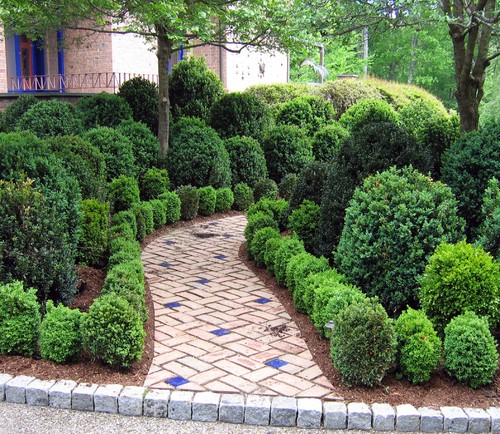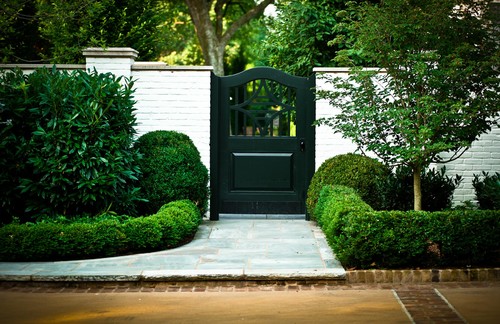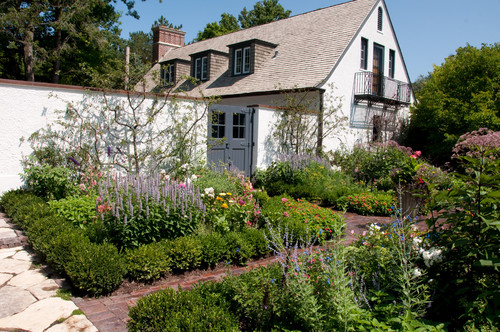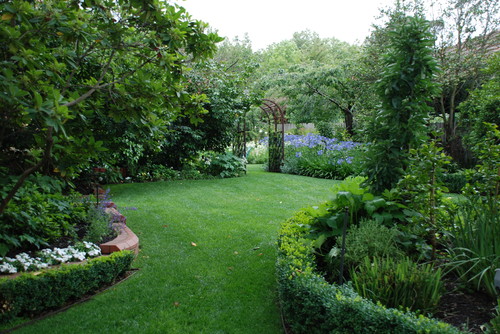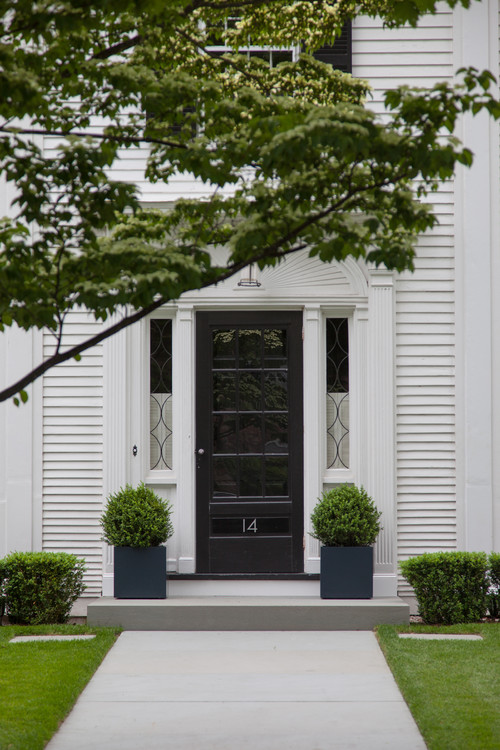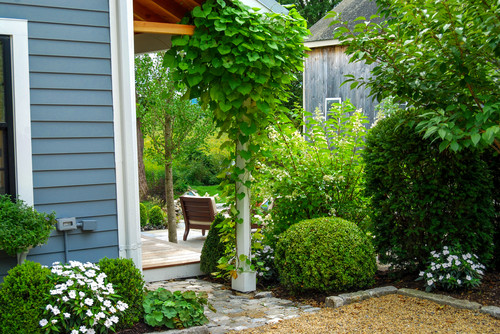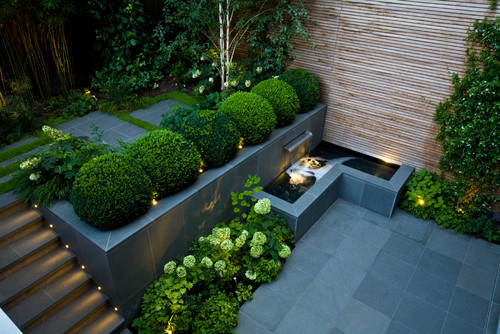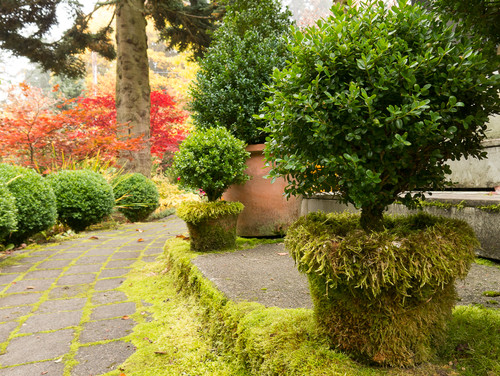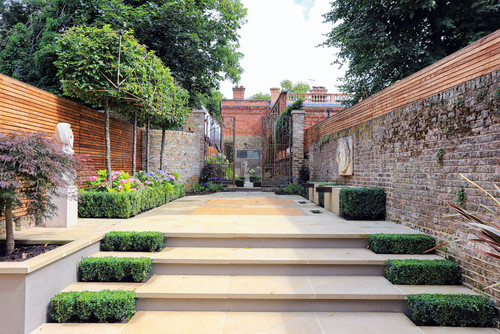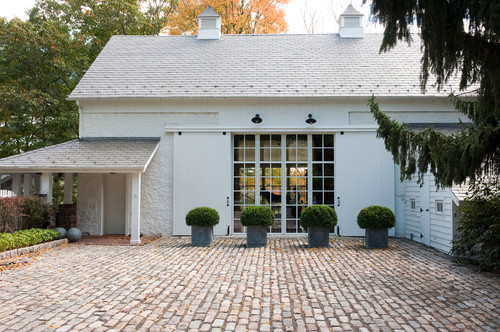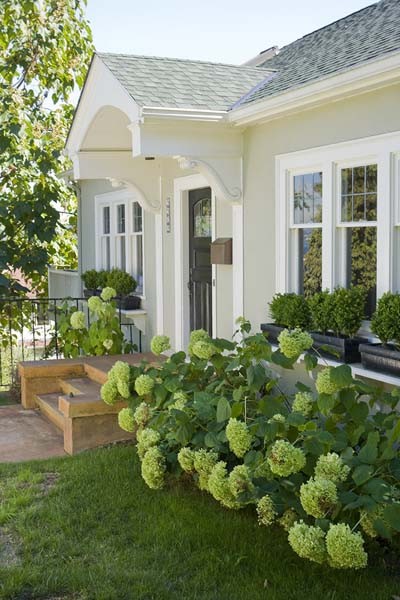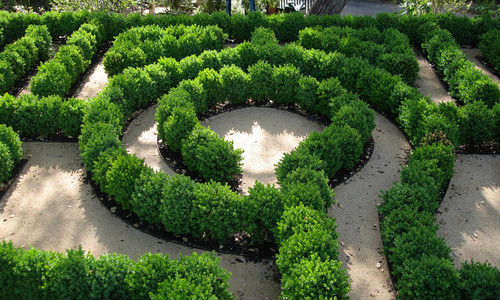
By Lauren Dunec Hoang / Houzz contributor
Widely used in both formal and more casual gardens, boxwoods (Buxus spp.) are one of the most popular shrubs in landscape design. With rich green foliage year-round, an ability to grow both in sun and partial shade and a high tolerance for pruning, they’re more versatile than many other shrubs. In winter boxwoods provide structure, while in summer they act as a dark backdrop for blooming perennials. Here are a dozen ideas for adding boxwoods to your garden.
Choosing your boxwood. All boxwoods are in the Buxus genus, with around 70 different species and hundreds of cultivars. Common, or English, boxwood (B. sempervirens, USDA zones 5 to 8) gets bigger, grows faster and has more pointed leaves than dwarf English boxwood (B. sempervirens ‘Suffruticosa’, zones 5 to 8). Dwarf English boxwood is particularly prized for topiary and edging, as its slow-growing habit and dense form requires less pruning.
Both littleleaf boxwood (B. microphylla, zones 6 to 9) and Korean boxwood (B. sinica var. insularis, zones 4 to 9) have narrow leaves and a compact form. Of all the Buxus species, Korean boxwood can survive in the lowest temperatures (down to Zone 4), making it the best choice for cold-winter regions.
Designing With Boxwoods
1. Accentuate a garden gate. The gate may officially mark the entryway to this garden, but a pair of large boxwoods gives the arrival real presence. Clipped into sculptural balls, the boxwood looks good year-round and could be wrapped with twinkling white lights in winter.
2. Add structure to informal gardens. Looser gardens can benefit from the addition of boxwoods to add structure to free-form beds of perennials and billowing grasses. Boxwoods look attractive year-round, which can help ease transitions in the garden as flowers fade and perennials die back, or if beds are left bare in winter.
3. Edge a garden bed. The top choices for low-growing hedges are boxwood varieties that have been cultivated to stay compact, such as dwarf English ( sempervirens ‘Suffruticosa’), Wee Willie (B. sinica var. insularis ‘Wee Willie’) and ‘Morris Midget’ (B. microphylla var. japonica ‘Morris Midget’). Plant along garden borders to define planting beds or edge the beds of a kitchen garden.
4. Make a stately entrance. Place a potted boxwood on either side of the front door for a welcoming entrance display that takes far less effort to maintain than seasonal annuals. Plant the boxwoods in a well-drained potting mix and keep the soil moist but not too damp.
5. Soften corners. Shaped into tightly clipped spheres or left as looser mounds, boxwoods can help round out the corners of garden beds. Center a single boxwood on the corner of a bed or arrange a trio of boxwoods with staggered heights in a tight grouping. Softening corners can be particularly useful in small gardens or tight intersections where you might be tempted to clip a corner moving from one space to the next.
6. Plant en masse. For maximum sculptural impact, plant many boxwoods together and keep them all clipped into globes. The repetitive curved shapes have a peaceful, almost hypnotic, quality as sunlight moves over them. To plan for pruning, space the boxwoods with small gaps between them to allow someone to step into the bed to access plants in the center.
7. Plant a room divider. A row of boxwood orbs separates an upper terrace from a lower courtyard in this garden in Berkshire, England. Kept to about 2½ feet tall and wide, the boxwood balls help define the two areas without blocking the view from one to the other.
8. Dissuade deer. In gardens that are prone to hungry four-legged visitors, boxwoods can be used in place of other shrubs, such as azalea, arborvitae, roses and yew, that are frequently nibbled. Deer avoid boxwoods thanks to their bitter alkaloid-rich foliage — the same compound that gives boxwood leaves their slightly astringent smell.
9. Emphasize edges. While we usually see boxwoods sheared as hedges or grown into globes, shaping them into rectangular blocks can be surprisingly effective in emphasizing hardscape geometry. In this London garden, boxwoods clipped into low rectangles mimic the form of the stairs, while larger boxwood cubes highlight the geometry of the water feature to the right.
10. Gussy up a parking area. Potted boxwoods placed equidistant along the side of a parking area help soften an expanse of cobblestones. Using potted containers in an open parking area can also help direct guests where to park — keeping cars well away from the post of an awning or the living room windows, for example.
11. Tuck into window boxes. Boxwoods are great plants for window boxes, as they require little tending and their dark green leaves complement flowers of any hue. In spring, plant edging lobelia (Lobelia erinus, zones 10 and 11) below the boxwood for a profusion of blooms through summer. Once the flowers begin to look tired, replace them with bronze- or purple-leaved coral bells (Heuchera spp., zones 4 to 9) for fall and winter interest.
12. Create a labyrinth. While it’s definitely on the high-maintenance end of the care spectrum, a boxwood labyrinth can be a beautiful addition to a formal landscape. If you’re starting with new boxwoods, plant them half as far away from each other as the mature width stated on the plant tag. This spacing will get the boxwoods to mature into a nice tight hedge, leaving no gaps in the labyrinth.
EDITOR’S NOTE: This article is from Houzz. Hoang is landscape designer and was previously a garden editor for Sunset Magazine and in-house designer for Sunset’s Editorial Test Garden.
